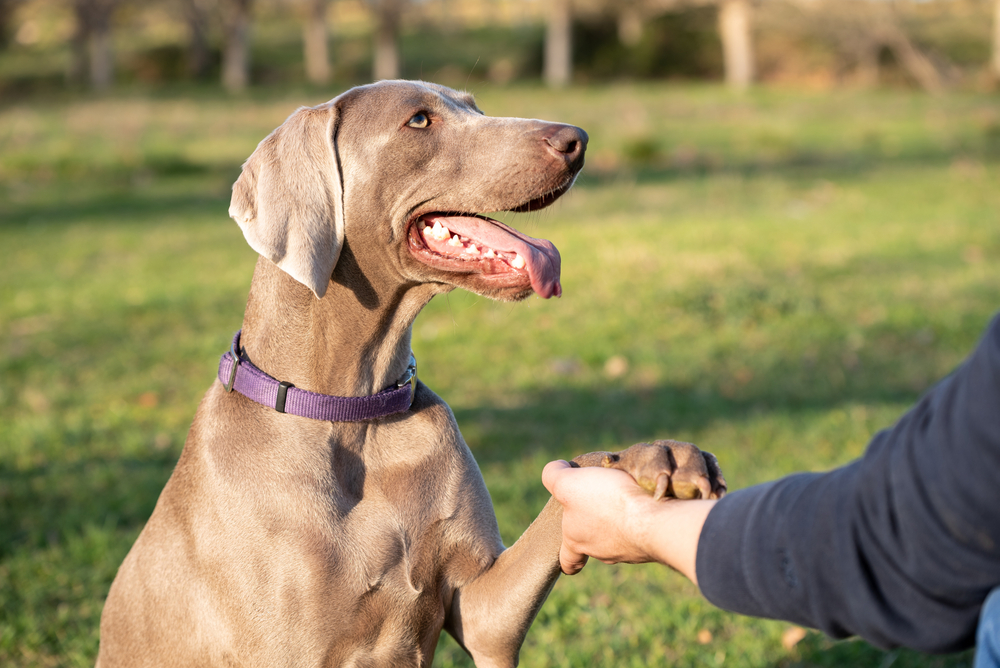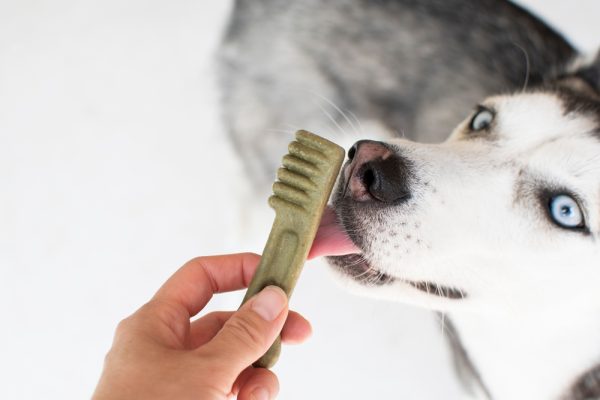In this article
View 8 More +Weimaraners are gorgeous, large dogs that were bred to be hunting companions. Pet parents worldwide love them for their friendliness, intelligence, and devotion. Most have solid blue, gray, or silvery gray coats, but a few have white blazes on their chests. Their amber or blue-gray eyes are stunning and one of their most prominent features. They’re also known as Grey Ghosts.
Breed Overview
Height:
23 – 27 inches
Weight:
55 – 90 pounds
Lifespan:
10 – 13 years
Colors:
Blue, gray, silver-gray
Suitable for:
Active families who regularly enjoy outdoor activities and are looking for large, friendly companions
Temperament:
Intelligent, devoted, friendly, energetic, and great with kids
Weimaraners are mixes of several breeds, and there may even be Bloodhound blood coursing through their veins. Sources suggest they may also have German and French hunting dog heritage.
They are skilled canine athletes, and they need lots of exercise to keep the Weimaraner’s behavior in check.. They’re also stunningly sweet and wonderfully smart, and they love hanging out with their owners.
Weimaraner Characteristics

Weimaraner Puppies

Working with a reputable breeder is usually the easiest way to find Weimaraner puppies. Word of mouth can help you get references, and veterinarians can also be a great resource.
You can attend dog shows to meet breeders, and breed clubs frequently have useful information. It’s sometimes possible to find adoptable dogs through rescue organizations and shelters, but Weimaraner puppies are not very common in shelters.
Puppies can usually go to their forever homes when they’re between 8 and 10 weeks old, and most can start learning basic commands. Because Weimaraners are so intelligent, early training is essential to prevent unwanted behavior.
Puppy classes are ideal for improving their socialization skills. They can help them become well-adjusted canine citizens who are confident, comfortable, and well-behaved in various situations.
Weimaraner Breed Origin & History
Weimaraners are originally from Germany. The breed isn’t that old; they’ve only been around since the 1800s. Before they lived as pets, they were used to hunt big game like wolves, boars, and bears and worked as all-around pointing and retrieving hunting dogs.
They first made it to the United States in the 1920s, but Weimaraners took a few decades to become popular. The breed became more common in the United States in the 1950s.


Temperament & Intelligence of the Weimaraner
Weimaraners are active, friendly, and great at following commands. Most love spending time with their favorite people and adore being included in whatever activities their humans are involved in.
They’re also intelligent and can become bored if they don’t have companions to engage with or activities to keep them busy. They typically have high energy levels and need lots of exercise to stay centered.
Most genuinely dislike being left alone for long periods and are inclined to develop separation anxiety when left alone for too long, which can lead to excessive barking, escape attempts, and destructive behavior.
Bored Weimaraners often turn to digging and chewing to entertain themselves. They have also been known to open doors and gates. They make wonderful companions for active people who enjoy outdoor activities like hiking and camping and have plenty of time to spend with their canine companions.
Are These Dogs Good for Families? 👪
Weimaraners are fantastic with children and make reliable playmates for older kids. They’re unlikely to get tired of playing and are hardy enough to tolerate roughhousing from unruly children.
However, they should be supervised around babies and small children since they’re large enough to knock them off their feet.

Does This Breed Get Along With Other Pets? 🐶 😽
Weimaraners can get along reasonably well with other dogs, provided they’ve been exposed to solid early socialization and have learned how to interact nicely with others.
They’re not great with cats due to their hunting instincts, but if they grow up with them when they’re puppies, they’re more likely to get along. Small animals like hamsters or gerbils must be kept in a room that your Weimaraner cannot access.

Things to Know When Owning a Weimaraner
You may be ready to adopt a Weimaraner, but before you do, check out these requirements to determine if you’re ready to care for them for several years.
Food & Diet Requirements 🦴
Weimaraners must eat food designed for large-breed dogs to ensure they get all the required nutrients. High-quality commercial wet food and kibble formulations are ideal, and although it’s difficult to select the right brand because of the numerous options, your veterinarian can help you develop a healthy diet for your pup.
Weimaraners love food, so feeding them the correct amount is an important part of keeping their weight under control, which is critical for their overall health.

Exercise 🐕
Weimaraners are elegant and athletic and need 1 ½ hours or more of daily exercise. While regular walks are great, they generally do best when they can engage in high-octane activities during which they can burn off lots of energy.
Those who don’t get enough physical activity can have too much pent-up energy, leading to destructive behavior. They enjoy running agility courses, dock diving, and games like frisbee. Weimaraners also make excellent jogging and hiking partners.
Training 🎾
Weimaraners are incredibly smart, and they learn tricks and commands quickly. Their intelligence makes solid early training absolutely essential to keep them from learning bad habits, and they’re better suited to experienced owners.
However, first-time owners can enroll their dogs in obedience classes to help with training. Fun, positive-reinforcement-based training is crucial since Weimaraners are sensitive dogs that don’t react well to harsh methods.

Grooming ✂️
Weimaraners are generally easy to groom. They have short, soft coats that only require moderate attention, but they do shed. Weekly brushing is usually all that’s needed to keep their coats in top shape.
However, their long ears must be regularly checked and cleaned to keep ear infections at bay. Weimaraners, like all dogs, should receive at-home dental care. Regular tooth brushing is one of the most important tasks pet parents can do to keep dental problems from developing. Regular nail trims are also required.
Health and Conditions 🏥
Weimaraners live for 10 to 13 years, which is about average for large-breed dogs. There are a few conditions they are prone to developing, including entropion, hip dysplasia, bloat, and hypothyroidism.
Entropion occurs when a dog’s eyelid rolls inward, which causes corneal irritation. Surgery is often required to fix the condition. Hip dysplasia is a joint condition that commonly affects large dogs. It makes it difficult for them to get around and can lead to the development of arthritis.
Bloat is a potentially fatal condition that occurs when a dog’s stomach ends up cut off from blood due to stretching caused by food or gas. Hypothyroidism is an endocrine disease that can cause signs such as weight gain and lethargy.
- Entropion
- Hip dysplasia
- Bloat
- Hypothyroidism
Male vs Female
Females range in height between 23 and 25 inches at the shoulder compared to males, who top out at around 27 inches. Female Weimaraners also weigh less.
Most weigh between 55 and 75 pounds, and males weigh 70 to 90 pounds. Neutering and spaying dogs can reduce sex-hormone-driven behavior, such as roaming and mounting in many pets.

3 Little-Known Facts About the Weimaraner
1. Weimaraners Have Inspired Artists
With their gorgeous coats and mesmerizing eyes, it’s no surprise that they inspired artists. William Wegman’s work includes several Weimaraners. Wegman owned one named Man Ray, who appears in many of the artist’s photographs and videos.
2. They’re Popular With Celebrities and Politicians
Grace Kelly owned a Weimaraner, as did President Dwight D. Eisenhower, whose companion was named Heidi. Heidi lived with the Eisenhower family in the White House. Before Grace Kelly became the Princess of Monaco, she was given a Weimaraner as a gift.
3. They’re Striped at Birth
Weimaraners are actually born with stripes that disappear after a few days. Their eyes start blue and change to amber or blue-gray over time. Several breeds have gray coats, but the gorgeous silver of the Weimaraner’s coat helps it stand out and led to the nickname “gray ghost.”


Final Thoughts
The Weimaraner dog breed is a friendly, active and fun breed that adores exploring the great outdoors. They’re large dogs with elegant bodies and soft, sleek coats that come in various silvery hues of gray and blue.
They make wonderful family dogs since they’re devoted and loving and generally do as asked. However, they become attached to their favorite people and can develop separation anxiety if left alone for too long.
They have high energy levels and need lots of activity to stay mellow. Bored Weimaraners who haven’t gotten enough exercise are prone to become destructive, but with the proper training, they make exceptional pets.
See also:
- Alpha Dog Training: 11 Vet-Approved Tips
- How to Prevent Fleas on Dogs: 15 Most Effective Vet-Approved Methods
Featured Image Credit: JuditBerescik Shutterstock

















